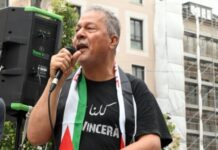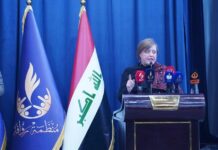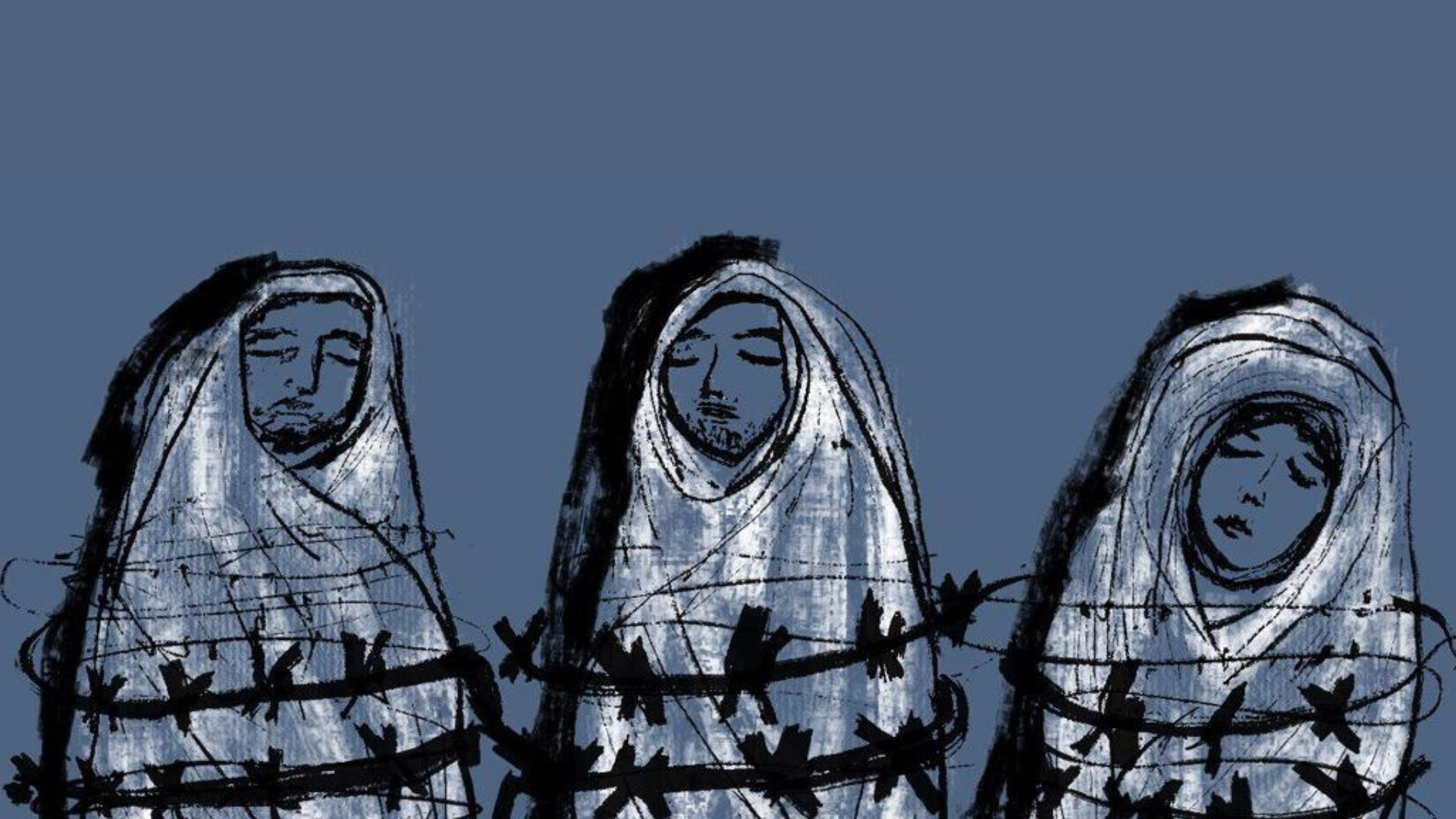
27 August marks the International Day for the Retrieval and Liberation of the Bodies of the Martyrs, held captive by the Zionist regime in occupation morgues, freezers and so-called “numbers cemeteries,” as well as in the notorious torture camp, Sde Teiman. The day of action was called for by the Palestinian National Campaign for the Recovery of the Bodies of Martyrs, as well as the Palestinian prisoners’ institutions. In the past year — as part and parcel of the ongoing Zionist/imperialist genocide in Gaza as well as the ongoing assault on the Palestinian people as a whole — the number of the martyrs known to be held captive by the Zionist regime has risen dramatically.

Today, there are 552 known Palestinian martyrs held in the morgues and “numbers cemeteries,” as well as at least 9 Lebanese martyrs of the Jammoul resistance movement, Elie Harb, Michel Saliba, Hussam Hijazi, Jamal Sati, Farjalla Fouani, Iyad Kser, Hassan Daher, Hasan Moussa and Yehya Khaled. This is in comparison to 398 bodies of the martyrs held one year ago, in 2023.

However, this number does not convey the extent of the crime; multiple released detainees from Gaza held at the Sde Teiman torture camp, where extreme physical torture, sexual abuse and assault, murder, starvation and abuse of all forms have been routinely used against masses of Palestinians from Gaza abducted by the invading genocidal army, have testified to the presence of over 1,500 bodies of martyrs held there; the occupation regime has returned around 428 martyrs’ bodies en masse.
As the International Campaign to Liberate the Remains of Palestinian Martyrs, a project supported by over 150 Palestinian, Arab and international organizations, including Samidoun, noted in the call to action it issued in March 2023:
“The occupation pursues a fascist policy in its treatment of the Palestinian and Arab martyrs. By refusing to give their families the opportunity to bury their loved ones, the occupation uses the remains of the martyrs as a mechanism for psychological torture of their families by detaining them for years and using them as a card for negotiation with the Palestinian resistance.”
“The Palestinian people have made clear that this barbaric policy will never ‘deter’ Palestinian youth from taking part in the resistance. These martyrs remain prisoners of the occupation even after death, and their families and the Palestinian people as a whole have every right to liberate, honour and bury them in ceremonies worthy of the sacrifices they made for the cause of Palestine, for return and liberation.”
Click here to endorse and support the campaign. Read the call to action in English, French, Arabic, Spanish, German, Swedish
Of the detained martyrs, 256 Palestinians (as well as the 9 Lebanese martyrs) are detained in “numbers cemeteries,” where martyrs are buried with a number, rather than a name, affixed to their graves; and 296 are held in the occupation’s freezers and morgues since the return of the policy of imprisoning bodies in 2015. While the martyrs are free, the occupation imprisons their bodies as a mechanism of collective punishment targeting their families and communities as a whole.
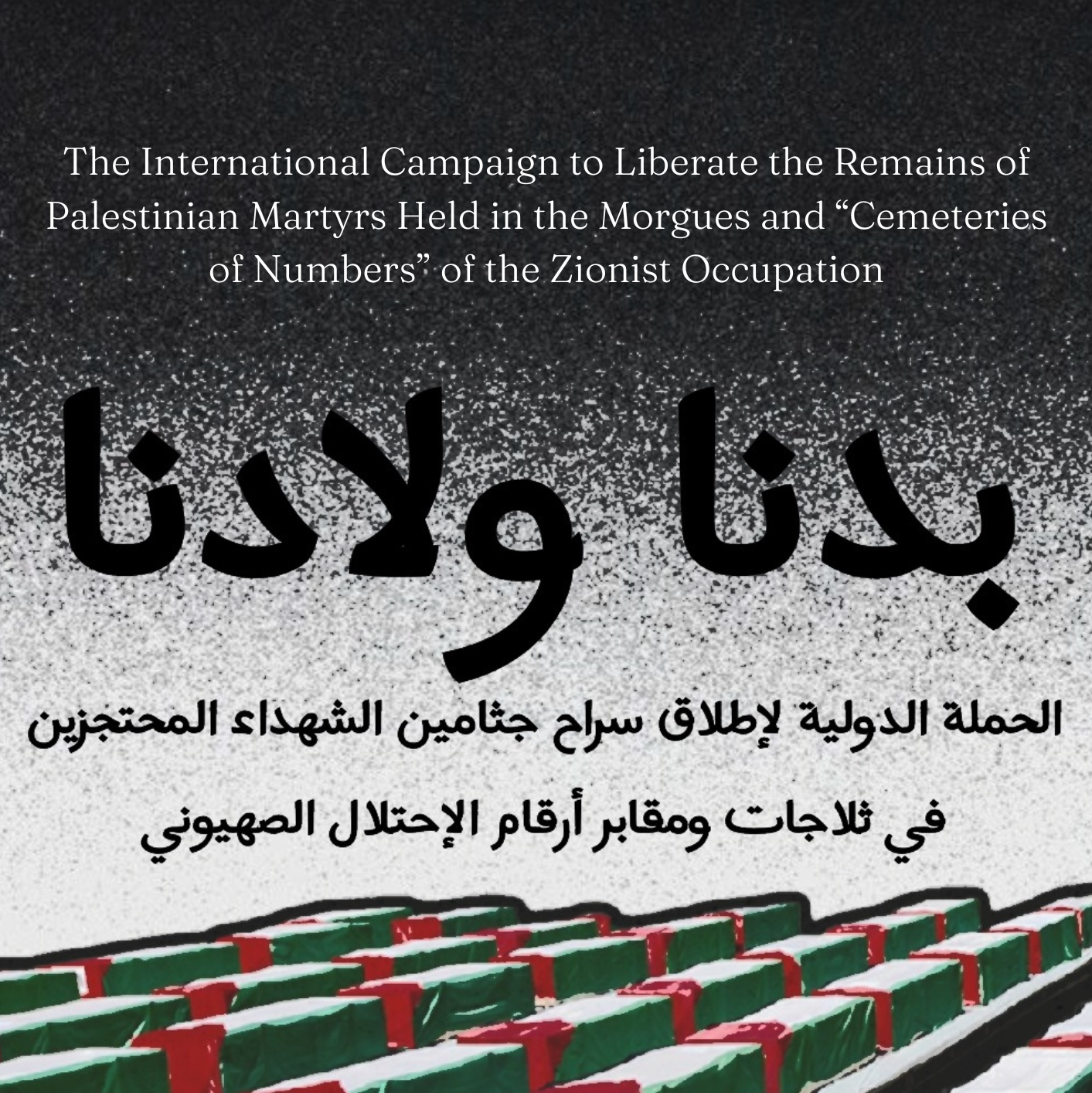
Of the imprisoned martyrs, there are 32 martyrs of the prisoners’ movement whose bodies are held captive by the Zionist regime. These include, infamously, the leader, freedom fighter, intellectual and writer Walid Daqqa, martyred inside Zionist prisons on 7 April 2024 after being repeatedly denied release and subjected to systematic medical neglect, and Sheikh Khader Adnan, whose life was taken after 86 days of hunger strike and the occupation’s deliberate refusal to provide him with medical care. Walid Daqqa’s wife, Sana Salameh, and their young daughter, Milad, have been vigorously campaigning for the release of his body in a case that highlights the racist nature of the Zionist regime and its war upon the entire Palestinian people, including Palestinian citizens of “Israel” like Daqqa and his family.
The 32 captive martyrs of the prisoners’ movement, whose lives were lost behind bars, many due to medical neglect and/or torture and abuse, are:
- Anis Dawla, whose body has been imprisoned since 1980
- Aziz Oweisat, whose body has been imprisoned since 2018
- Fares Baroud, whose body has been imprisoned since 2019
- Nasser Taqatqa, whose body has been imprisoned since 2019
- Bassam al-Sayeh, whose body has been imprisoned since 2019
- Saadi al-Gharably, whose body has been imprisoned since 2020
- Kamal Abu Waer, whose body has been imprisoned since 2020
- Sami al-Amour, whose body has been imprisoned since 2021
- Daoud Zubaidi, whose body has been imprisoned since 2022
- Nasser Abu Hmeid, whose body has been imprisoned since 2022
- Sheikh Khader Adnan, whose body has been detained since 2 May 2023
- Omar Daraghmeh, whose body has been detained since 23 October 2023.
- Arafat Hamdan, whose body has been detained since 24 October 2023
- Majed Zaqoul, whose body has been detained since 6 November 2023.
- An unnamed worker from Gaza held in the Anatot camp, whose body has been detained since November 2023.
- Abdul Rahman Mar’i, whose body has been detained since 13 November 2023.
- Thaer Abu Asab, whose body has been detained since 18 November 2023.
- Abdul-Rahman al-Bahsh, whose body has been detained since 1 January 2024.
- Mohammed Ahmad al-Sabbar, whose body has been detained since 8 February 2024
- Mohammed Abu Sneineh, a child martyr, whose body has been detained since 12 February 2024
- Khaled al-Shawish, whose body has been detained since 19 February 2024
- Izz al-Din al-Banna, whose body has been detained since 20 February 2024
- Ahmed Rizq Qudaih, whose body has been detained since 16 February 2024
- Asif al-Rifai, whose body has been detained since 29 February 2024
- Jumaa Abu Ghanima, whose body has been detained since March 2024 (martyrdom announced on 16 March 2024)
- Walid Daqqa, whose body has been detained since 7 April 2024
- Dr Adnan al-Bursh, one of Gaza’s most prominent surgeons, whose body has been detained since 19 April 2024
- Mustafa Abu Ora, whose body has been detained since 15 July 2024
- Islam al-Sarsawi, whose body has been detained since 4 April 2024
- Omar Abdel-Aziz Junaid, whose body has been detained since 17 June 2024
- Kifah Dabaya, whose body has been detained since 11 August 2024
- Zaher Raddad, whose body has been detained since 25 August 2024.
It is critical that we take action on an international level to popularize the campaign to liberate the bodies of the martyrs. This is part and parcel of the struggle for the dignity and lives of the Palestinian people — and of humanity — being led by the Palestinian armed resistance confronting the genocidal Zionist regime and its imperialist partners in the United States, Germany, France, Britain, Canada and fellow imperialist powers.
We call upon Palestinian and Arab networks, solidarity groups supporting the prisoners’ struggle and boycott campaigns around the world to join in the international campaign to recover and release the remains of Palestinian martyrs, and to expand the support and solidarity for Palestinian prisoners and martyrs everywhere around the world, for their liberation and the liberation of Palestine from the river to the sea.
We are republishing the statement below from the Palestinian National Campaign to Retrieve the Martyrs’ Bodies:
National Day for the Retrieval of Martyrs’ Bodies – August 27th
Facts about the Martyrs Whose Bodies are Held in Numbers Cemeteries, Morgues, and the Sde Teiman Military Base:
The number of martyrs whose bodies are held amounts to 552, including 256 in numbered cemeteries and 296 since the return of the policy of holding bodies in 2015. Among them are:
- 9 female martyrs.
- 32 martyrs from the prisoners’ movement.
- 55 children under the age of 18.
- 5 martyrs from the 1948 occupied territories.
- 6 martyrs from Palestinian refugees in Lebanon.
Since the start of the genocide against our people in Gaza, the occupation has escalated its policy of holding bodies. Since the war, the occupation has held 149 bodies, which constitutes more than half of the martyrs held since 2015. It is important to note that this figure does not include the bodies held from the Gaza Strip. The number of martyrs from Gaza held by the occupation is estimated to be in the hundreds, but there is no official statement from the occupation regarding the actual number of bodies from Gaza to this day.
Key Data on the Crime of Holding Martyrs’ Bodies (As a Systematic Historical Policy):
The crime of holding martyrs’ bodies, practiced by the Israeli occupation, is one of the prominent historical policies used as part of the crime of collective punishment against martyrs and their families, and as a mechanism of control and punishment of Palestinians. This issue has passed through several stages and has been closely linked to the escalating level of resistance and confrontation against the Israeli occupation system. Since the occupation of Palestine in 1948, the occupation has used this policy, continuing its implementation until 2008, and resumed it with a decision by the Israeli cabinet in 2015, at the beginning of the popular intifada. The occupation did not stop at holding the bodies but also imposed certain conditions when returning the bodies. It also applied a classification policy as part of the conditions imposed on families, particularly affecting martyrs who hold Jerusalemite identity cards, by imposing harsh and unjust restrictions in the context of the occupation’s desire for revenge against the living and the martyrs.
This issue underwent legal transformations since 2017. On December 14, 2017, the so-called Israeli Supreme Court decided to postpone its ruling invalidating the holding of martyrs’ bodies to allow the Israeli authorities to legislate clear and explicit provisions authorizing the military and police leadership to hold martyrs’ bodies. In September 2019, the Supreme Court issued a decision allowing the military commander to hold the martyrs’ bodies and bury them temporarily for use as bargaining chips in negotiations. It also imposed broad conditions authorizing the previously mentioned authorities to issue orders to hold the bodies of some martyrs. In reality, the vast majority of the martyrs whose bodies are held do not meet the conditions imposed by the court, making this issue a new phase in the role played by the so-called Supreme Court in consolidating the crime of holding martyrs’ bodies. This was followed by efforts by the Israeli Knesset to legislate a law authorizing the occupation police to hold martyrs’ bodies, and later an amendment was made to the “Anti-Terrorism Law.”
Holding Martyrs’ Bodies Since the Start of the Genocide:
The ongoing genocide against our people in Gaza has brought about transformations on all levels, with the enormous crimes committed by the Israeli occupation. The issue of martyrs’ bodies is one of the most prominent of these issues, with the number of bodies held by the occupation increasing. After the beginning of the genocide, the number of bodies held reached 149, which constitutes more than half of the martyrs held since 2015. This number does not include the martyrs from Gaza whose bodies are held, estimated to be in the hundreds.
To this day, there is no official statement from the occupation regarding the actual number of bodies held from Gaza, in addition to the fact that the occupation employs a policy of concealing identities as another face of the systematic crime of enforced disappearance, instead assigning numbers to the bodies. The only information that has emerged regarding the bodies of martyrs from Gaza held by the occupation was in July 2024, when the Hebrew newspaper Haaretz revealed in an article that the Israeli occupation holds about 1,500 bodies of Palestinians whose identities are unknown, stored in refrigerated containers inside the military base known as Sde Teiman, and they were classified by numbers rather than names. The newspaper mentioned that the condition of the bodies had reached a certain stage of decomposition, with some missing limbs and others without identifiable features.
During the war, the occupation handed over the bodies of 428 unidentified martyrs in several batches, and they were buried in mass graves in Khan Younis and Rafah in the southern Gaza Strip. The scene of the occupation handing over the bodies of martyrs in blue bags was one of the most striking images, reflecting the level of savagery of the occupation and its disdain for human dignity as one of the aspects of the ongoing genocide for more than ten continuous months.
Holding Martyrs’ Bodies in Violation of International Conventions and Charters:
This policy contradicts all international customs and charters that stipulate respect for the victims and the return of their bodies. The relevant rules of international humanitarian law concerning the treatment of the dead, their remains, and their graves include Rule 112 on searching for and collecting the dead, Rule 113 on protecting the dead from pillage and mutilation, Rule 114 on the return of the dead’s remains and their personal belongings, Rule 115 on the disposal of the dead, and Rule 116 on identifying the dead.
The First Geneva Convention of 1949, in Article 17, emphasizes the importance of decent and respectful burial, stating that the parties to the conflict must “ensure the dead are honorably interred, if possible according to the rites of the religion to which they belonged, that their graves are respected, grouped according to nationality, and properly maintained and marked so that they can always be found.”
In addition to Article 17 of the First Geneva Convention, Article 120 of the Third Geneva Convention, Article 130 of the Fourth Geneva Convention, and Article 34 of the Additional Protocol require facilitating the return of the bodies and remains of the dead.
The National Campaign for the Retrieval of Martyrs’ Bodies and Palestinian human rights organizations renew their constant demand for the international legal system to resume its necessary role in stopping the genocide and to stand up for humanity by addressing the terrifying state of paralysis that surrounds its role in the ongoing Palestinian tragedy that has persisted for decades and to exert pressure to free the bodies of our martyrs.
Free the Martyr Captives’ Bodies, Free the Martyr Captives:
We have names… We have a homeland.
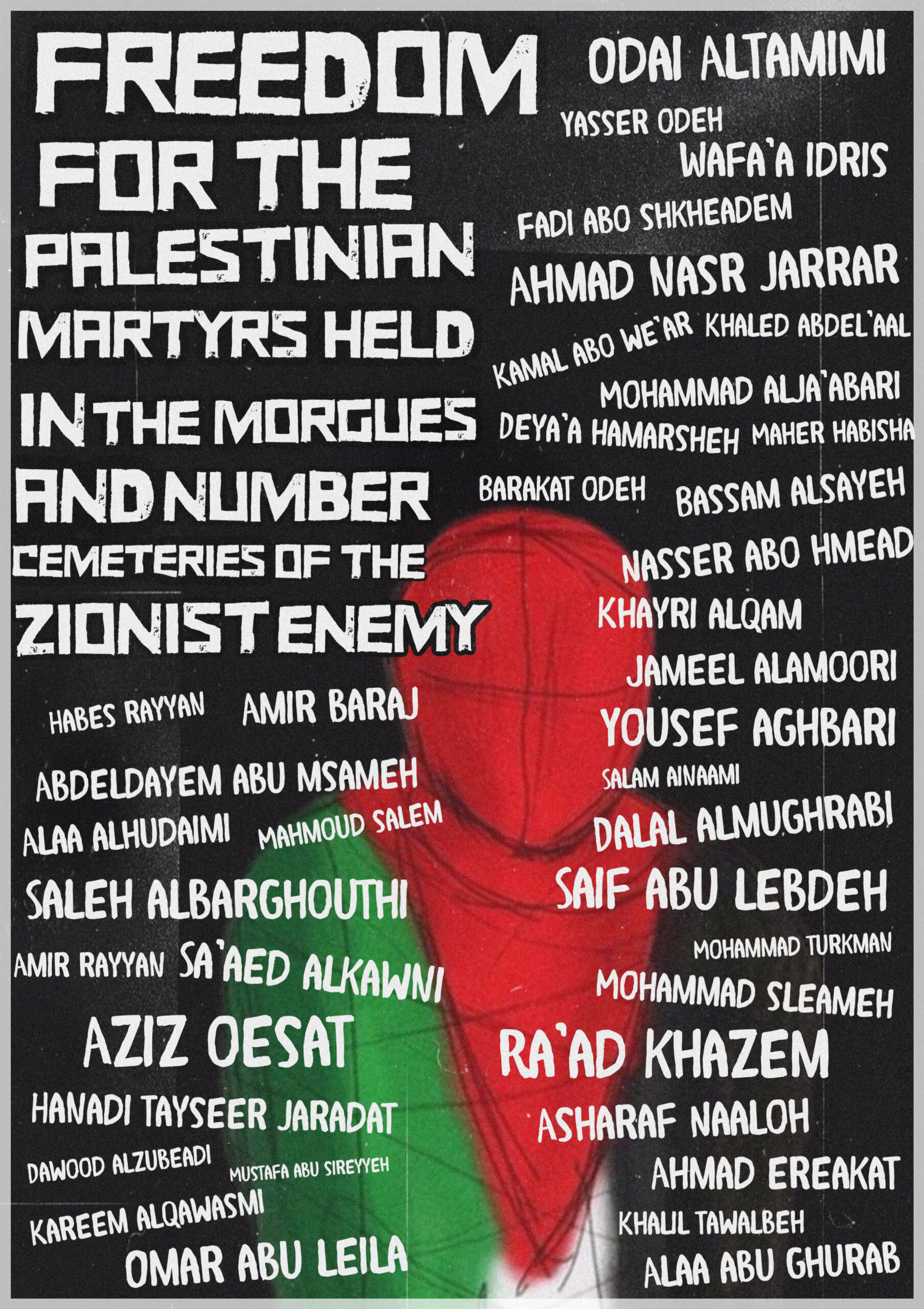
Discover more from Samidoun: Palestinian Prisoner Solidarity Network
Subscribe to get the latest posts sent to your email.

